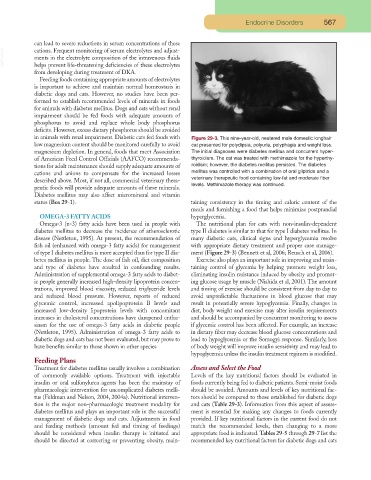Page 548 - Small Animal Clinical Nutrition 5th Edition
P. 548
Endocrine Disorders 567
can lead to severe reductions in serum concentrations of these
VetBooks.ir cations. Frequent monitoring of serum electrolytes and adjust-
ments in the electrolyte composition of the intravenous fluids
helps prevent life-threatening deficiencies of these electrolytes
from developing during treatment of DKA.
Feeding foods containing appropriate amounts of electrolytes
is important to achieve and maintain normal homeostasis in
diabetic dogs and cats. However, no studies have been per-
formed to establish recommended levels of minerals in foods
for animals with diabetes mellitus. Dogs and cats without renal
impairment should be fed foods with adequate amounts of
phosphorus to avoid and replace whole body phosphorus
deficits. However, excess dietary phosphorus should be avoided
in animals with renal impairment. Diabetic cats fed foods with Figure 29-3. This nine-year-old, neutered male domestic longhair
low magnesium content should be monitored carefully to avoid cat presented for polydipsia, polyuria, polyphagia and weight loss.
magnesium depletion. In general, foods that meet Association The initial diagnoses were diabetes mellitus and concurrent hyper-
of American Feed Control Officials (AAFCO) recommenda- thyroidism. The cat was treated with methimazole for the hyperthy-
tions for adult maintenance should supply adequate amounts of roidism; however, the diabetes mellitus persisted. The diabetes
cations and anions to compensate for the increased losses mellitus was controlled with a combination of oral glipizide and a
veterinary therapeutic food containing low-fat and moderate fiber
described above. Most, if not all, commercial veterinary thera-
levels. Methimazole therapy was continued.
peutic foods will provide adequate amounts of these minerals.
Diabetes mellitus may also affect micromineral and vitamin
status (Box 29-1). taining consistency in the timing and caloric content of the
meals and furnishing a food that helps minimize postprandial
OMEGA-3 FATTY ACIDS hyperglycemia.
Omega-3 (n-3) fatty acids have been used in people with The nutritional plan for cats with non-insulin-dependent
diabetes mellitus to decrease the incidence of atherosclerotic type II diabetes is similar to that for type I diabetes mellitus. In
disease (Nettleton, 1995). At present, the recommendation of many diabetic cats, clinical signs and hyperglycemia resolve
fish oil (enhanced with omega-3 fatty acids) for management with appropriate dietary treatment and proper case manage-
of type I diabetes mellitus is more accepted than for type II dia- ment (Figure 29-3) (Bennett et al, 2006; Reusch et al, 2006).
betes mellitus in people. The dose of fish oil, diet composition Exercise also plays an important role in improving and main-
and type of diabetes have resulted in confounding results. taining control of glycemia by helping promote weight loss,
Administration of supplemental omega-3 fatty acids to diabet- eliminating insulin resistance induced by obesity and promot-
ic people generally increased high-density lipoprotein concen- ing glucose usage by muscle (Nishida et al, 2001). The amount
trations, improved blood viscosity, reduced triglyceride levels and timing of exercise should be consistent from day to day to
and reduced blood pressure. However, reports of reduced avoid unpredictable fluctuations in blood glucose that may
glycemic control, increased apolipoprotein B levels and result in potentially severe hypoglycemia. Finally, changes in
increased low-density lipoprotein levels with concomitant diet, body weight and exercise may alter insulin requirements
increases in cholesterol concentrations have dampened enthu- and should be accompanied by concurrent monitoring to assess
siasm for the use of omega-3 fatty acids in diabetic people if glycemic control has been affected. For example, an increase
(Nettleton, 1995). Administration of omega-3 fatty acids to in dietary fiber may decrease blood glucose concentrations and
diabetic dogs and cats has not been evaluated, but may prove to lead to hypoglycemia or the Somogyi response. Similarly, loss
have benefits similar to those shown in other species of body weight will improve insulin sensitivity and may lead to
hypoglycemia unless the insulin treatment regimen is modified.
Feeding Plans
Treatment for diabetes mellitus usually involves a combination Assess and Select the Food
of commonly available options. Treatment with injectable Levels of the key nutritional factors should be evaluated in
insulin or oral sulfonylurea agents has been the mainstay of foods currently being fed to diabetic patients. Semi-moist foods
pharmacologic intervention for uncomplicated diabetes melli- should be avoided. Amounts and levels of key nutritional fac-
tus (Feldman and Nelson, 2004, 2004a). Nutritional interven- tors should be compared to those established for diabetic dogs
tion is the major non-pharmacologic treatment modality for and cats (Table 29-3). Information from this aspect of assess-
diabetes mellitus and plays an important role in the successful ment is essential for making any changes to foods currently
management of diabetic dogs and cats. Adjustments in food provided. If key nutritional factors in the current food do not
and feeding methods (amount fed and timing of feedings) match the recommended levels, then changing to a more
should be considered when insulin therapy is initiated and appropriate food is indicated. Tables 29-5 through 29-7 list the
should be directed at correcting or preventing obesity, main- recommended key nutritional factors for diabetic dogs and cats

